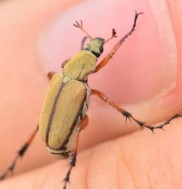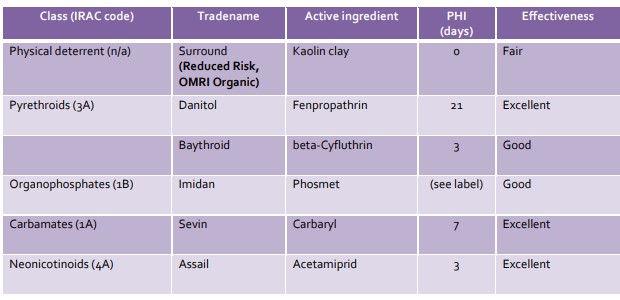Rose Chafer
Rose chafer adults typically begin to appear around this time of year in Wisconsin. In this article we will specifically discuss rose chafer as a pest of grape vines in the state; however, they feed on and can be a pest of many fruit crops in the state, including apple, cherry, raspberry, and strawberry.
| Common Name | Rose chafer |
| Order | Coleoptera |
| Family | Scarabaeidae |
| Scientific Name | Macrodactylus subspinosus (Fabricius) |

Identification and Life Cycle
Rose chafers overwinter in Wisconsin as larvae in the soil, pupate in the spring, and emerge as adults, seemingly all at once, generally in late May or early June. The adults are conspicuous ½ inch long beetles, sandy-colored, with long legs which get darker towards the feet. Adult rose chafers feed, mate and lay eggs during their approximately 3-week life-span. The eggs are laid in the soil, and larvae are C-shaped grubs which look similar to the larvae of Japanese beetle. These larvae feed in the soil on grass and other plant’s roots. There is only one generation of rose chafer per year in Wisconsin.
Damage Symptoms
Rose chafers feed on the flowers, fruit and leaves of grapes. Leaf feeding can be mistaken for that of the Japanese beetle, as both skeletonize the leaves, leaving the leaf veins intact. The more damaging rose chafer injury comes when the early-emerging adults feed on and destroy flower buds and flowers.
Monitoring and Control
Monitoring for the conspicuous adult beetles should begin in late May and continue until they are no longer found in the vineyard. Because feeding on flower buds can cause such extensive crop loss, an economic threshold as low as two beetles per vine is recommended for chemical controls.
When monitoring, it is best to inspect 25 vines near the edges and corners of the vineyard, and 25 from within the vineyard block. By inspecting vines throughout each block, you can determine if the entire vineyard is affected, or if infestations are localized and a spot treatment could sufficiently control these beetles.
Cultural control: Rose chafers prefer to oviposit (lay eggs) in sandy soil, so vineyards on or near sandy soil sites are at greater risk of rose chafer infestation. We recommend monitoring earlier in the season and more carefully in these sandy sites. Cultivating between the rows of the vineyard in early spring may destroy some rose chafer pupae. This generally only works when populations are already relatively low, or in combination with a chemical control. The use of mass trapping or monitoring using a trap is not recommended, as the trap may attract beetles in to the crop more quickly than it is able to trap them out of the crop, leading to an increase in damage.
Chemical control: Chemical control for rose chafer, when necessary, can begin immediately pre-bloom and continue through around pea-sized berries. A list of available insecticides to control rose chafer in grape is provided in the following table. For other fruit crops, be sure to read the label to ensure they are registered in Wisconsin for that specific crop. There are many other tradenames available, and we do not recommend these that are listed above other options. All product recommendations can be found in the Midwest Fruit Pest Management Guide. Additionally, you should always fully read and follow the label before spraying any pesticide.


